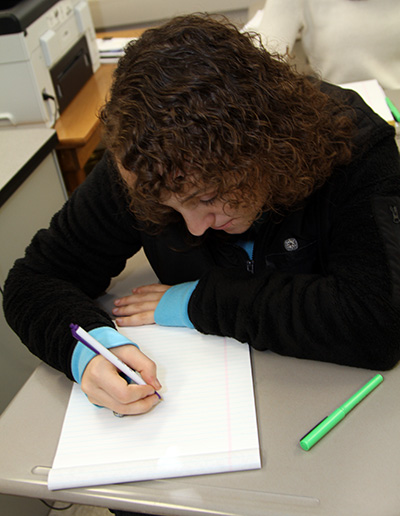Which study skills strategies can improve students’ academic performance?
Page 5: Note-taking
Did You Know?
Many middle and high school teachers present information through lectures. In fact, secondary teachers often lecture for approximately 50% of the class period.
As students progress through school and are increasingly expected to learn information presented during lectures or to independently glean it from content-area texts, note-taking becomes more and more important. In content-area classrooms such as science or social studies, note-taking is an essential skill, an effective way for students to retain and recall information. More specifically, taking notes helps students to:
- Understand the information they read or that is presented during a lecture (i.e., improved comprehension)
- Organize and process important information
- Actively engage with the material
- Put the information into their own words and order
Joseph Boyle, developer of Strategic Note-taking, a validated strategy for taking notes during lectures, discusses the importance of teaching note-taking skills (time: 1:58).

Joseph Boyle, PhD
Associate Professor, Special Education
Temple University, Philadelphia, PA
Transcript: Joseph Boyle, PhD
It’s important to teach note-taking skills to students with LD and ADHD because research shows that lectures or discussions occur 40 to 50 percent of the time in content-area classes such as science and social studies. Particularly students with learning disabilities have a difficult time processing information, so their slower processing often leads to problems in terms of recording notes. There’s two main areas that they have problems with. One is that working memory becomes overloaded, so students have a difficult time processing verbal information. When that happens, students can’t process the current incoming information quickly enough to be able to write it down. Because their processing information is a slower rate, they miss the new information that is coming in. When this happens, students end up recording fewer notes. When we compare students with LD compared to their peers with no learning disabilities, we see that they record about half as many lecture points as their peers.
A second aspect with executive functioning, working memory, if a student has a difficult time focusing attention on the important information, they have a tough time discerning important from unimportant lecture information. A third issue involves recording vocabulary notes. In content-area courses, particularly science, lectures are often laden with a lot of vocabulary words. And when we looked at students’ notes in terms of how much vocabulary they record, again it’s only about half as many vocabulary words as their non-disabled peers. And vocabulary is actually an important component of recording notes because it’s actually moderately correlated with test performance. So students who record lots of vocabulary often do better in terms of their scores on tests.
Skills Needed for Note-Taking
- Sustained attention
- Ability to receive (written text or lecture) and process information (identifying main ideas and details) simultaneously
- Ability to comprehend the text
- Capacity to identify important information and determine what to write
- Organization and production of intelligible notes
- Handwriting (if using paper-and-pencil method) or computer skills
Mary Anne Prater-Doty offers more insight into why students with LD and other high-incident disabilities struggle with taking notes (time: 2:25).

Mary Anne Prater-Doty, PhD
Professor Emeritus
Brigham Young University
Transcript: Mary Anne Prater-Doty, PhD
Teachers cannot assume that students know the learning strategies that they need to succeed. This applies to all students but particularly students with learning disabilities and attention deficit/ hyperactivity disorder. Note-taking is one of these learning strategies. Being able to take notes can facilitate inclusion in secondary schools. There are several characteristics of students with learning disabilities and other high-incidence disabilities that make note-taking difficult for them. One may be auditory processing difficulties. They can physically hear what is being said, but they may have difficulty interpreting and understanding what they hear. Another characteristic is selective attention. Selective attention is the ability to identify what is relevant and to focus only on that which is relevant. If the teacher is making a presentation, students with a selective attention difficulty have difficulty identifying what is it about what the teacher said that really is important that I should write down. Other characteristics involve language and writing difficulties. Both of those would inhibit note-taking. All of these difficulties also transfer to taking notes from text. So it’s not just what they hear in a presentation, but perhaps taking notes or outlining a chapter. They may have visual processing difficulties. They might have difficulty reading, but if they can read they don’t necessarily process what they are reading with comprehension difficulties. The selective attention, the vocabulary, writing difficulties, all of that make note-taking hard for them.
As more and more students with learning disabilities, in particular, are enrolling in higher education in universities and colleges, having good note-taking skills can be critical to those students. I just read a study that compared students with learning disabilities, low-achieving students, and high-achieving students in college and found that note-taking amongst some of the other study strategies was the skill that they lacked, that probably contributed to their low performance in college.
Teachers can use any of a number of validated strategies to encourage note-taking during lectures or independent reading. Four such strategies are described in the table below. Note that the first three have been validated for use during lectures and the last for use during independent reading.
| Strategies for Taking Notes | ||||||||||||||||||||||||||||||||
|---|---|---|---|---|---|---|---|---|---|---|---|---|---|---|---|---|---|---|---|---|---|---|---|---|---|---|---|---|---|---|---|---|
| Strategy | Description | |||||||||||||||||||||||||||||||
|
Guided Notes |
To help guide students through the lecture, teachers provide an outline containing the main ideas and related concepts being presented. Typically, blanks are inserted in the notes where key facts or concepts should appear. As information is presented during a lecture, the student completes the guided notes by writing missing content into the blanks. Click here to learn how to prepare guided notes and teach students how to use them. |
|||||||||||||||||||||||||||||||
|
Teachers can prepare guided notes by:
Invertebrates
(Close this panel) |
||||||||||||||||||||||||||||||||
|
Strategic Note-Taking |
Most appropriate for middle and high school students, this strategy is aimed at teaching skills that aid in good note-taking. Teachers provide the students with a form that prompts them to focus on teacher cues and vocabulary and helps them to organize main ideas and summarize these key points. Click here to learn how to teach students how to use the strategic note-taking strategy. Click here to download a copy of the strategic note-taking paper. |
|||||||||||||||||||||||||||||||
|
One goal of the strategic note-taking strategy is to teach students how to take notes independently without teacher-provided prompts. First, though, the teacher will need to spend time teaching the students how to effectively use the strategic note-taking paper during lectures.
(Close this panel) |
||||||||||||||||||||||||||||||||
|
AWARE |
This mnemonic helps secondary students record cued lecture points and to take more complete notes. Click here to view the steps. |
|||||||||||||||||||||||||||||||
|
The AWARE strategy consists of five steps that students can use to more effectively take notes.
*emphasis and number cues
Suritsky, S., & Hughes, C. (1996) cited in Boyle, J. R., & Weishaar, M. (2001). The effects of strategic notetaking on the recall and comprehension of lecture information for high school students with learning disabilities. Learning Disabilities Research & Practice, 16(3), 133–141. Suritsky, S., & Hughes, C. (1993) cited in Mastropieri, M. A., Scruggs, T. E. (2010). Teaching study skills. In J. Johnston & A. Davis (Eds.), The Inclusive Classroom: Strategies for Effective Differentiated Instruction (4th ed.) (pp. 249–265). Upper Saddle River, NJ: Pearson. (Close this panel) |
||||||||||||||||||||||||||||||||
|
Columnar Formats |
In this strategy, students typically divide their paper into two or three columns, which allows them to visually organize different types of information (e.g., main ideas, details). Click here to view samples of each type of columnar format. |
|||||||||||||||||||||||||||||||
|
Students using a two-column format (see the example below) typically record keywords, main ideas, or chapter subheadings in the left column and supporting details or explanations in the right column. Students should keep the information in the right column short and to the point.
For younger students or students who prefer visual representations, a three-column format (see the example below) is often beneficial. The first two columns are identical to the columns in the two-column format, with keywords, main ideas, or chapter subheadings recorded in the left column and supporting details or explanations in the right column. The third column is available for students to draw a picture of the concept or idea.
(Close this panel) |
||||||||||||||||||||||||||||||||
Note-Taking While Reading: General Tips
Regardless of the note-taking strategy the student uses when reading independently, he or she might find it beneficial to:
- Highlight important information in a given text using highlighting pens (not always a possibility, especially in textbooks) or highlighting tape. Highlighted text can serve as a visual reminder of important ideas. However, highlighting alone is often not enough to result in increased text comprehension. Students must also take written notes.
- Process the main ideas by reviewing the completed notes and adding to them or by reorganizing the notes around a set of questions or thematic headings.
- Rewrite their notes using chapter headings to ensure that the main ideas from each section were recorded.
Note-Taking During Lectures: General Tips
To help students become more efficient note-takers (regardless of the strategy they use), teachers can provide them with a number of tips that can be easily implemented. Following are only a few.
- Date and label the notes.
- Write key words or phrases instead of complete sentences.
- Use abbreviations. (Remind students that this is the same process they use when texting.)
- Denote (e.g., with a star) information that the teacher stresses.
- Write down any information the teacher writes on the board or indicates is important to know.
- Draw a blank for missed information. (The student can consult the teacher, a peer, or the text for the missing information.)
Even as teachers take steps to increase their students’ note-taking skills, there are also a number of simple adjustments they can make to their lectures to facilitate the process. Some of these are:
Cueing — Teachers can use visual cues (e.g., a PowerPoint presentation or overhead projector with key points, a topic outline, or diagrams) and audio cues (e.g., “There are three important things to remember about this topic: One…, Two…”, “You should write this next statement down in your notes.”) to draw attention to the important information in a lecture that should be written in notes.
Pacing — Teachers can slow the pace of the lecture and insert planned pauses (e.g., two minutes) so that students can record more notes, review their existing notes, and have an opportunity to ask questions.
Allowing time for review — Teachers can allow the students time at the end of the lecture (e.g., five minutes) to fill in gaps, confer with other students, or ask questions.
For Your Information
For some students, taking notes is not an option because they struggle with writing or cannot sustain their attention. For these students, teachers can:
- Create an audio recording of the lecture
- Have another student copy his or her notes
- Provide copies of the presentation or relevant handouts
- Teach students to use abbreviations when taking notes
- Encourage the student to preview the topic to become more familiar with new terms and concepts
Tip
Whether taking notes while reading a text or during a lecture, students must review their notes. This increases recall of information and leads to improved test scores.Activity
Some students with disabilities, in particular those with LD and ADHD, have difficulty processing information. They often:
- Have difficulty identifying important information during lectures
- Focus on irrelevant information
- Fail to take notes, take inadequate notes, or record everything the teacher says
With this in mind, listen as Erin describes her note-taking process (time: 1:25). Based on her comments, select one of the note-taking strategies listed above to teach Erin how to improve her note-taking. Explain why you chose this method and be sure to include why you believe it will help Erin specifically.

Transcript: Erin
I don’t like note-taking really. It tends to distract me from what’s going on unless they’ve put up a PowerPoint and I’m copying down what’s on the PowerPoint. I get very frustrated that I can’t keep up with the teacher, what they’re saying and the notes that I’m taking. And so I stop focusing on what’s happening and just trying to catch up with the last sentence or the last piece of information they give, and I miss out on the next piece of information. So then I don’t have that piece of information, and so then it falls apart because once I miss one piece then I’m just frustrated that I couldn’t quite keep up with the notes. And so I don’t really like notes.
I’ve had a problem with knowing what was important to write down, and that’s caused a problem because I try and write down everything that they say because no one ever really taught me what is and isn’t important. And so trying to write everything down just gets a little too long, and that causes me to fall behind in the notes, and so it’s been a struggle that I’ve had to try and sort out what is and isn’t important.
I really don’t review my notes. Honestly, notes are very frustrating for me, and so I don’t like to look over my notes again. I might go back and read the text again, or look over the book, or even Google it and look up the stuff online and try to learn it a different way and get it from a different point of view, but I don’t really go back and look over my notes.




